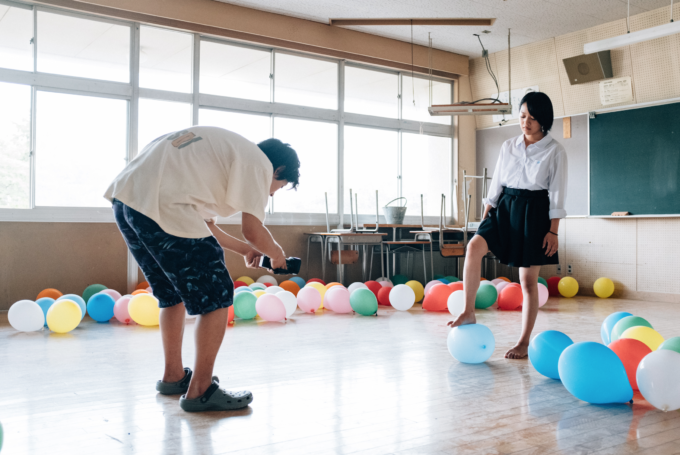Written By: Saiya Floyd
Genta Matsugami’s “Demolition Girl” transports the audience to rural Japan and offers a look into the life of a working class teenage girl. Set in Gunma Prefecture in the months before the girl’s last year of high school, “Demolition Girl” is a quiet portrait of resilience.
Cocoa, the titular character is played by a compelling Aya Kitai. She has resigned herself to getting a job upon graduating, until she finds out her deceased mother had put aside some money for her to go to college. Suddenly a new world of possibilities has opened, and Cocoa is determined to go National University with the money from her mother, loans, and whatever she herself is able to squirrel away. Help is not coming from her father or older brother, who live off government benefits and spend their time watching TV and gambling.
To supplement her minimum wage jobs, Cocoa also makes fetish videos with the help of one of her brother’s former friends. The videos show Cocoa stomping on things, and apparently do very well. Or well enough that a disinterested Cocoa keeps doing it. The videos are a means to an end for her — she earns more money making videos than at her job selling sausages at an amusement park — and her ticket out of Gunma.

As filmed by Matsugami, Gunma is a pretty, if unexciting place. There are a lot of fields and open areas, and there’s something calm in Matsugami’s visual style. Most of the scenes are made up of muted palettes: there are a lot of whites, grays, deep greens, and navy blues. It’s aesthetically appealing, but does convey a sense of languid humdrumness. It’s clear why a bright teenage girl would want to leave for opportunity beyond Gunma’s perpetually gray skies. Matsugami captures a hazy quality, that surreal end of summer feeling, where it seems it has always been summer and will always be summer. It’s easy to grow complacent and lose oneself in that feeling, with time trickling away unnoticed. But Cocoa, who watches her brother and father waste away in their living room on a steady diet of TV and self pity, refuses to be so trapped.
With that goal — escape — being Cocoa’s main drive, it’s hard not to root for her. “The problem that this story tells is common across the world,” Matsugami says. The universality of Cocoa’s underdog narrative is very relatable. She works for everything she has and meets every set back with more determination. “You’re hungry,” one of Cocoa’s friends tells her. She’s right, and it’s what makes Cocoa such a compelling lead. She is ravenous for a better life, so much so that the audience starts to share in her hunger, making her dreams theirs. Cocoa will not let financial hardship or anything else stand in her way. She wants a better life for herself, and after watching how hard she works, how she takes everything in stride, it’s nearly impossible for the audience to not want that too.
As Cocoa, Kitai is compelling, often displaying a stoic determination in the face of her problems, only to shift and let down her guard, reminding us of her young age. When with her friends, we can see Cocoa’s more playful side. She is, after all, just a teenage girl who wants to spend time with her friends and go to college like other students in her grade. At one point, Cocoa exits a meeting with a school counsellor, having received good news about getting loans. Flanked by her friends, she lets out a cathartic scream. It’s a scream of joy, but one tinged with suppressed anger at the life she’s had to live. When Cocoa is alone, or with her family, there is a marked shift in how she behaves. She is more serious, determinedly shouldering her responsibilities, as she knows there is no one else to help. She has only herself. Kitai plays her role with poise and grit, making moments when we see the cracks in Cocoa’s cool exterior all the more poignant.
The story was inspired by Matsugami’s own observations. “I feel really uneasy [about] the current situation in Japan, especially issues over women when … I came up with the image of a high-school girl who confronted [these] difficulties with a pickaxe in her hand. I wanted this powerless teenage girl to represent my thoughts and feelings.” There is something about the imagery of Cocoa literally stomping her way out of poverty with the videos, determined to not get stuck in a dead-end. But there is also something to be said about the quiet role of other women in the film.
It was Cocoa’s mother who saved money to help her go to college. It is Cocoa’s aunt who tells Cocoa about this (as her own father neglected to tell her), and ignites Cocoa’s dream to go to college. And Cocoa is often in the company of her two best friends — both girls. She works with one of her friends at her part time job and they study together. It is with her friends that she takes breaks and has moments where she can just be a teenager. Her friends might not understand her financial struggles, but they love and support her, and it’s obvious how much Cocoa values her relationship with them. She’s a hard worker and would give her all to whatever goal she set for herself. She’s a worthy protagonist for Matsugami’s frustrations. But the network of women who encourage Cocoa to dream bigger are equally important.
The contrast between this support system of women and the role of men in “Demolition Girl” is stark. There are of course Cocoa’s father and brother, who are a burden to her. Not only are they clearly negligent, but they ask her for money for food, pushing her into a caretaker role, taking what they can from her when they should be supporting her. Then there’s Cocoa’s “friend” who films and edits the fetish videos. Friend might be a strong word — Cocoa probably wouldn’t be hanging out with him if he wasn’t getting her money — but the two have at least a friendly business relationship, and he seems genuinely fond of her. But this doesn’t erase the fact that he is an adult filming a teenager for fetish videos for the sexual gratification of a target audience of other men. He does not protect Cocoa’s identity as carefully as he should, risking her privacy and future. There is another level of discomfort in the fact that in Cocoa’s videos she wears her school girl uniform, emphasizing her youth. (She turns 18 at around the midpoint of the film). Like Cocoa’s father and brother, he fails to protect Cocoa as much as he should.
To the men in her life, Cocoa is a caretaker or an object to be sexualized. In both cases, she is a resource, giving more than she is receiving. How many women can complain about being similarly reduced to a caretaker or sex object role? Watching the women in Cocoa’s life lift her up is beautiful and hopeful, but Matsugami goes a step further. He doesn’t just give Cocoa a support system against problems women face and her frustrations with them. By having his heroine literally crush things, Matsugami also gives his heroine (and the audience) catharsis.
Director: Genta Matsugami
Stars: Aya Kitai, Hiroki Ino, Haruka Imo, Yura Komuro, Ko Maehara, Ryohei Abe, Yota Kawase
Running Time: 1 hour 28 minutes
Genre: Narrative, Drama

